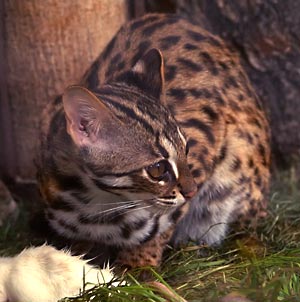|
| 질의: Mammal | 결과: 2439번째/3457 | |
Leopard Cat (Prionailurus bengalensis) - Wiki
| 제목: | Leopard Cat (Prionailurus bengalensis) - Wiki
| |

| 해상도: 300x302
파일크기: 21985 Bytes
등록시간: 2006:12:26 20:42:11
|
Leopard Cat
From Wikipedia, the free encyclopedia
[Photo] Prionailurus bengalensis in a zoo (Tierpark) - Berlin. Source http://de.wikipedia.org/wiki/Bild:Bengalkatze.jpg Date September 2005. Author F. Spangenberg - Der Irbis
The Leopard Cat (Prionailurus bengalensis) is a small wild cat of Southeast Asia. On average it is as large as a domestic cat, but there are considerable regional differences: in Indonesia the average size is 45 cm, plus 20 cm tail, while it is 60 cm/40 cm in the Amur region. The fur is also quite variable: it is yellow in the southern populations, but silver-grey in the northern ones. The chest and the lower part of the head are white. Leopard Cats bear black markings, that may be - dependent on the subspecies - spots or rosettes. It is a nocturnal animal, and usually eats rodents, birds, fish, reptiles, small mammals. It is usually a solitary animal except for the mating season. It has litters of 2 to 4 kittens and the gestation period can vary from 65 to 70 days.
The habitat of this cat is forests and rainforest both in low and mountainous areas, usually not arid areas. It lives close to watercourses and may be found in heights up to 3000 m. The Leopard Cat can climb trees skilfully. It is also able to swim, but will seldom do so.
The Leopard Cat is a nocturnal animal hunting for rodents, hares, birds and even bats. When entering villages, they may become dangerous for the poultry.
Subspecies
- Prionailurus bengalensis bengalensis, India, Bangladesh, Southeast Asian mainland, Yunnan
- Prionailurus bengalensis borneoensis, Borneo
- Prionailurus bengalensis chinensis, China, Taiwan
- Prionailurus bengalensis euptailura, eastern Siberia, Mongolia
- Prionailurus bengalensis horsfieldi, Himalaya
- Iriomote cat, Prionailurus bengalensis iriomotensis
- Prionailurus bengalensis javaensis, Java
- Prionailurus bengalensis manchurica, Manchuria
- Prionailurus bengalensis minutus, Philippines
- Prionailurus bengalensis sumatranus, Sumatra
- Prionailurus bengalensis trevelyani, eastern Pakistan
The Japanese island subspecies is of special interest. The Iriomote Cat (P. b. iriomotensis) lives exclusively on the tiny island of Iriomote. When it was discovered in 1967, it was regarded as a survivor of an extinct line of felines and placed in a separate genus Mayailurus. This view is still being discussed, some authorities still continue to classify the Iriomote Cat as a separate species, since it looks quite different from the mainland Leopard Cats: It has dark brown fur, a bushy tail, and it is not able to sheath its claws. They are also known as Yamamayaa (means "mountain cat") or Yamapikaryaa ("mountain sparkling-eyed") or Pingiimayaa ("escaped cat") to the islanders of Iriomote. The Iriomote cat is the most threatened subspecies with an estimated population of less than 100 individuals.
The Tsushima Cat was not discovered until 1988. First it was regarded as a separate species as well, then as a subspecies of the Leopard Cat, and now as a variety of the Manchurian subspecies (F. b. manchurica).
The Leopard Cat is sometimes captured and interbred with domestic cats to create a domesticated Bengal Cat with an appearance and behavior similar to the Leopard Cat while remaining safe for domestication.
http://en.wikipedia.org/wiki/Leopard_Cat
| The text in this page is based on the copyrighted Wikipedia article shown in above URL. It is used under the GNU Free Documentation License. You may redistribute it, verbatim or modified, providing that you comply with the terms of the GFDL. |
|
댓글 |
|---|
| | 손님 |
|
| nice picture |
| | 손님 |
|
Scientific Name: Prionailurus bengalensis (Kerr, 1792)
Synonyms: Felis bengalensis Kerr, 1792
Common Names:
English – Leopard Cat
French – Chat-léopard du Bengale, Chat de Chine
Spanish – Gato Bengalí, Gato de Bengala |
^o^
동물그림창고 똑똑전화 누리집
^o^
|
|
|